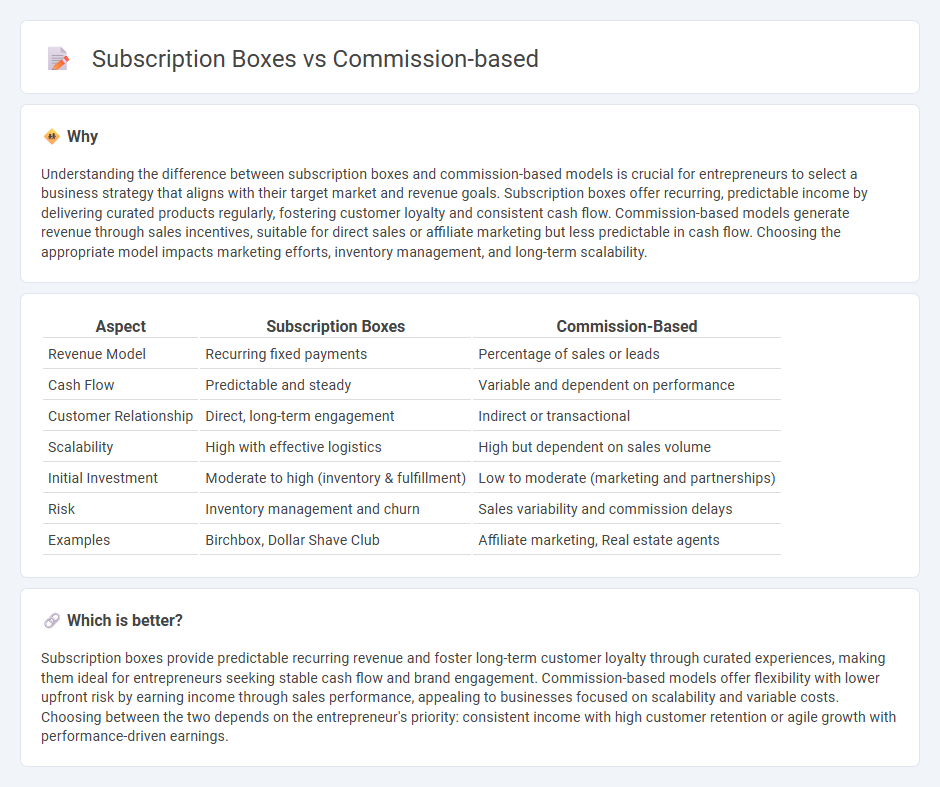
Subscription boxes offer a predictable revenue stream by charging customers a recurring fee for curated products, enhancing customer retention and brand loyalty. Commission-based models generate income through a percentage of each sale, providing flexibility and lower upfront costs but relying heavily on sales performance. Explore the advantages and challenges of each model to determine the best fit for your entrepreneurial venture.
Why it is important
Understanding the difference between subscription boxes and commission-based models is crucial for entrepreneurs to select a business strategy that aligns with their target market and revenue goals. Subscription boxes offer recurring, predictable income by delivering curated products regularly, fostering customer loyalty and consistent cash flow. Commission-based models generate revenue through sales incentives, suitable for direct sales or affiliate marketing but less predictable in cash flow. Choosing the appropriate model impacts marketing efforts, inventory management, and long-term scalability.
Comparison Table
| Aspect | Subscription Boxes | Commission-Based |
|---|---|---|
| Revenue Model | Recurring fixed payments | Percentage of sales or leads |
| Cash Flow | Predictable and steady | Variable and dependent on performance |
| Customer Relationship | Direct, long-term engagement | Indirect or transactional |
| Scalability | High with effective logistics | High but dependent on sales volume |
| Initial Investment | Moderate to high (inventory & fulfillment) | Low to moderate (marketing and partnerships) |
| Risk | Inventory management and churn | Sales variability and commission delays |
| Examples | Birchbox, Dollar Shave Club | Affiliate marketing, Real estate agents |
Which is better?
Subscription boxes provide predictable recurring revenue and foster long-term customer loyalty through curated experiences, making them ideal for entrepreneurs seeking stable cash flow and brand engagement. Commission-based models offer flexibility with lower upfront risk by earning income through sales performance, appealing to businesses focused on scalability and variable costs. Choosing between the two depends on the entrepreneur's priority: consistent income with high customer retention or agile growth with performance-driven earnings.
Connection
Subscription boxes and commission-based models are interconnected through their reliance on recurring revenue streams and performance-driven sales. Entrepreneurs leverage subscription box services to generate consistent income while utilizing commission-based partnerships to incentivize sales representatives or affiliates. This synergy enhances customer retention and maximizes profitability within entrepreneurial ventures.
Key Terms
Revenue Model
Commission-based revenue models generate income by taking a percentage of each sale, incentivizing companies to maximize transaction volume and customer engagement. Subscription boxes rely on recurring payments, providing predictable monthly or quarterly revenue streams and enhancing customer retention through curated experiences. Explore detailed insights to determine which revenue model best aligns with your business goals.
Customer Retention
Subscription boxes generate consistent revenue by fostering long-term customer loyalty through personalized, curated experiences tailored to individual preferences. Commission-based models rely on transactional sales, often resulting in fluctuating retention rates due to less predictable customer engagement and satisfaction. Explore how optimizing these strategies can significantly enhance customer retention and business growth.
Sales Cycle
Commission-based models typically shorten the sales cycle by incentivizing affiliates to close deals quickly, resulting in faster revenue generation and immediate performance tracking. Subscription box services often experience longer sales cycles due to customer acquisition efforts and recurring billing management, requiring sustained engagement and retention strategies. Explore the advantages of each sales approach to optimize your business growth.
Source and External Links
Everything you need to know about commission based pay - Primeum - Commission-based pay is a form of incentive compensation where employees earn money based on the income they directly generate for the company, usually calculated as a percentage of turnover, sales, or gross profit, with variations such as progressive, capped, and tiered commission schemes to motivate performance.
Commission (remuneration) - Wikipedia - Commissions are variable-pay incentives typically used in sales roles to motivate employees, calculated often as a percentage of revenue, and can include various structures like fixed salary plus commission or straight commission, with goals like quotas involved to align employee and company interests.
The pros and cons of commission-based pay for your employees - Commission-based pay compensates employees based on a percentage or flat rate of goods or services sold, with common pay structures including straight commission, base salary plus commission, variable commission, and draw against commission, commonly used in sales and client-based roles to incentivize performance.
 dowidth.com
dowidth.com